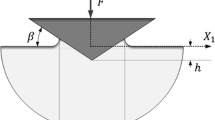Abstract
Experimental evidence to support Johnson's [6] analysis of the residual surface stress distribution produced in a flat surface by a spherical indenter is presented. The theory suggests that high residual stresses develop just outside the contact area as a result of the superposition of elastic unloading stresses onto the stresses at maximum load when the specimen has deformed plastically. The experiments involved the use of a semi-brittle steel, sufficiently hardened so that, while tensile stresses in the surface produced cracks, the substrate deformed plastically under the triaxial stress system beneath the indenter. Radial cracks produced by the indenter frequently extended after load removal, implying the presence of the high tensile circumferential residual stresses predicted by the theory. This work and recent studies of indentation loading of glasses show that there are important situations where residual stresses can contribute to their failure and wear.
Similar content being viewed by others
References
D. Scott,Wear 25 (1973) 199.
N. Tsushima, H. Muro andK. Nunome,ibid 25 (1973) 345.
E. Gervais andH. J. McQueen,J.I.S.I. 210 (1972) 189.
J. C. Tyler, R. A. Burton andP. M. Ku,Trans. ASLE 6 (1963) 255.
S.W. Pinegin, A. W. Orlov andV. M. Goodchenko, Proceedings of the 2nd Conference on dimensioning and strength calculation, Budapest (Hungarian Academy of Sciences, 1965) p. 411.
K. L. Johnson, in "Engineering Plasticity" (Cambridge University Press, 1968) p. 341.
H. Hertz,J. Reine Angew Math. 92 (1881) 156.
F. C. Frank andB. R. Lawn,Proc. Roy. Soc. A 299 (1967) 291.
T. R. Wilshaw,J. Phys. D: Appl. Phys. 4 (1971) 1567.
C. Hardy, C. N. Baronet andG. V. Tordion,Int. J. Numerical Methods in Engng. 3 (1971) 451.
D. Tabor,Proc. Roy. Soc. A 192 (1948) 247.
K. L. Johnson,Nature 199 (1963) 1282.
C. J. Studman, PhD Thesis, University of Cambridge (1974).
T. R. Wilshaw andW. E. Swindlehurst, Acoustic emission conference (Institute of Physics, London 1972).
H. H. Uhlig, "Fracture — an Advanced Treatise", Vol. 3, edited by H. Liebowitz, Academic Press, New York, 1971) p. 646.
B. R. Lawn andM. V. Swain,J. Mater. Sci. 10 (1975) 113.
B. R. Lawn andE. G. Fuller,ibid,10 (1975) 2016.
Author information
Authors and Affiliations
Rights and permissions
About this article
Cite this article
Studman, C.J., Field, J.E. The indentation of hard metals: the role of residual stresses. J Mater Sci 12, 215–218 (1977). https://doi.org/10.1007/BF00566260
Received:
Accepted:
Issue Date:
DOI: https://doi.org/10.1007/BF00566260




